2019 KIA SOUL reset
[x] Cancel search: resetPage 357 of 564
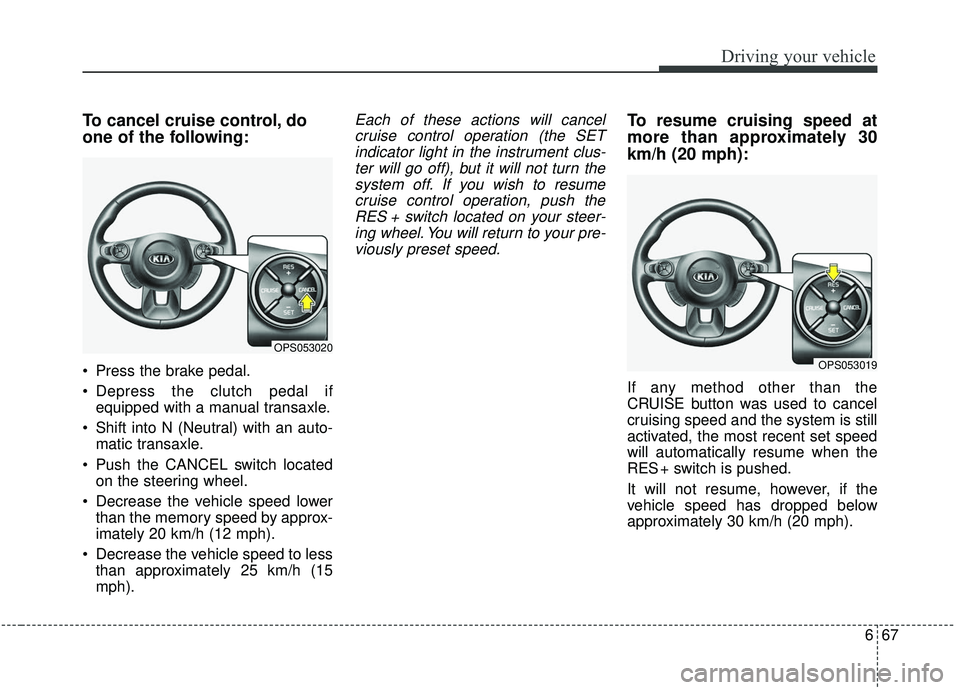
667
Driving your vehicle
To cancel cruise control, do
one of the following:
Press the brake pedal.
Depress the clutch pedal ifequipped with a manual transaxle.
Shift into N (Neutral) with an auto- matic transaxle.
Push the CANCEL switch located on the steering wheel.
Decrease the vehicle speed lower than the memory speed by approx-
imately 20 km/h (12 mph).
Decrease the vehicle speed to less than approximately 25 km/h (15
mph).
Each of these actions will cancelcruise control operation (the SETindicator light in the instrument clus-ter will go off), but it will not turn thesystem off. If you wish to resumecruise control operation, push theRES + switch located on your steer-ing wheel. You will return to your pre-viously preset speed.To resume cruising speed at
more than approximately 30
km/h (20 mph):
If any method other than the
CRUISE button was used to cancel
cruising speed and the system is still
activated, the most recent set speed
will automatically resume when the
RES + switch is pushed.
It will not resume, however, if the
vehicle speed has dropped below
approximately 30 km/h (20 mph).
OPS053020
OPS053019
Page 364 of 564
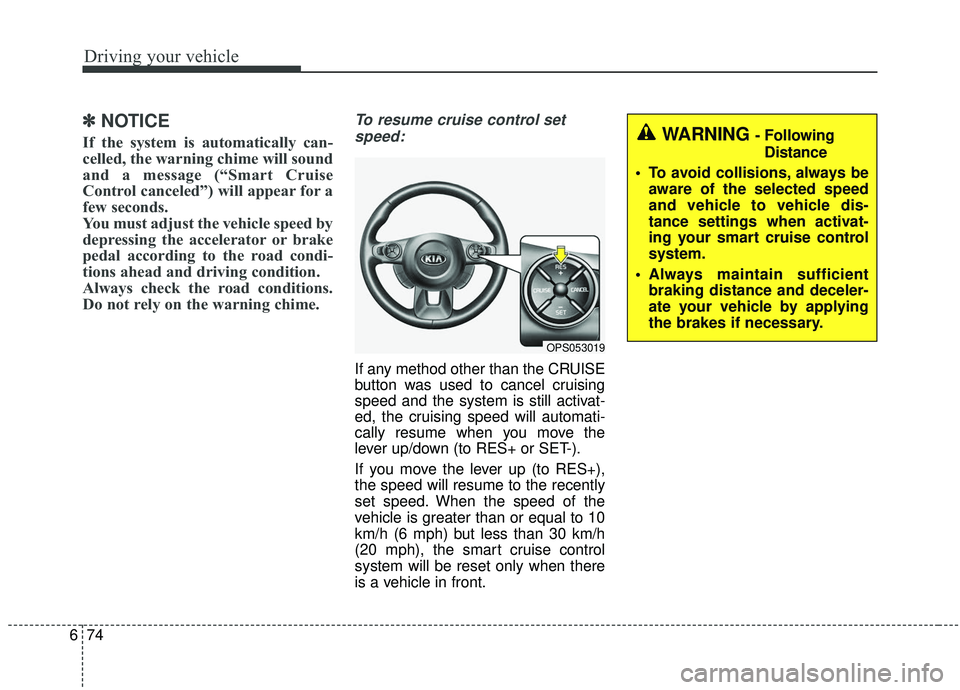
Driving your vehicle
74
6
✽ ✽
NOTICE
If the system is automatically can-
celled, the warning chime will sound
and a message (“Smart Cruise
Control canceled”) will appear for a
few seconds.
You must adjust the vehicle speed by
depressing the accelerator or brake
pedal according to the road condi-
tions ahead and driving condition.
Always check the road conditions.
Do not rely on the warning chime.
To resume cruise control set
speed:
If any method other than the CRUISE
button was used to cancel cruising
speed and the system is still activat-
ed, the cruising speed will automati-
cally resume when you move the
lever up/down (to RES+ or SET-).
If you move the lever up (to RES+),
the speed will resume to the recently
set speed. When the speed of the
vehicle is greater than or equal to 10
km/h (6 mph) but less than 30 km/h
(20 mph), the smart cruise control
system will be reset only when there
is a vehicle in front.
OPS053019
WARNING - Following Distance
To avoid collisions, always be aware of the selected speed
and vehicle to vehicle dis-
tance settings when activat-
ing your smart cruise control
system.
Always maintain sufficient braking distance and deceler-
ate your vehicle by applying
the brakes if necessary.
Page 376 of 564

Driving your vehicle
86
6
The drive mode may be selected
according to the driver’s preference
or road condition.
The system resets to be in the ECO
mode, when the hybrid system is
restarted.
If there is a problem with the instru-
ment cluster, the drive mode will be
in ECO mode and may not change to
NORMAL mode or SPORT mode. The mode changes whenever the
DRIVE MODE button is pressed.
❈
When normal mode is selected, it
is not displayed on the cluster.
ECO mode (Active ECO)
Active ECO helps improve
fuel efficiency by control-
ling certain engine and
transaxle system operat-
ing parameters. Fuel effi-
ciency depends on the
driver's driving habit and
road condition.
button is pressed and
the ECO mode is select-
ed, the ECO indicator
(green) will illuminate to
show that the Active
ECO is operating.
activated, it does not turn
off even though the
engine is restarted again.
To turn off the system,
press the DRIVE MODE
button again.
DRIVE MODE INTEGRATED CONTROL SYSTEM (IF EQUIPPED)
NORMAL
SPORT ECO
OPS056118
ECO
Page 411 of 564
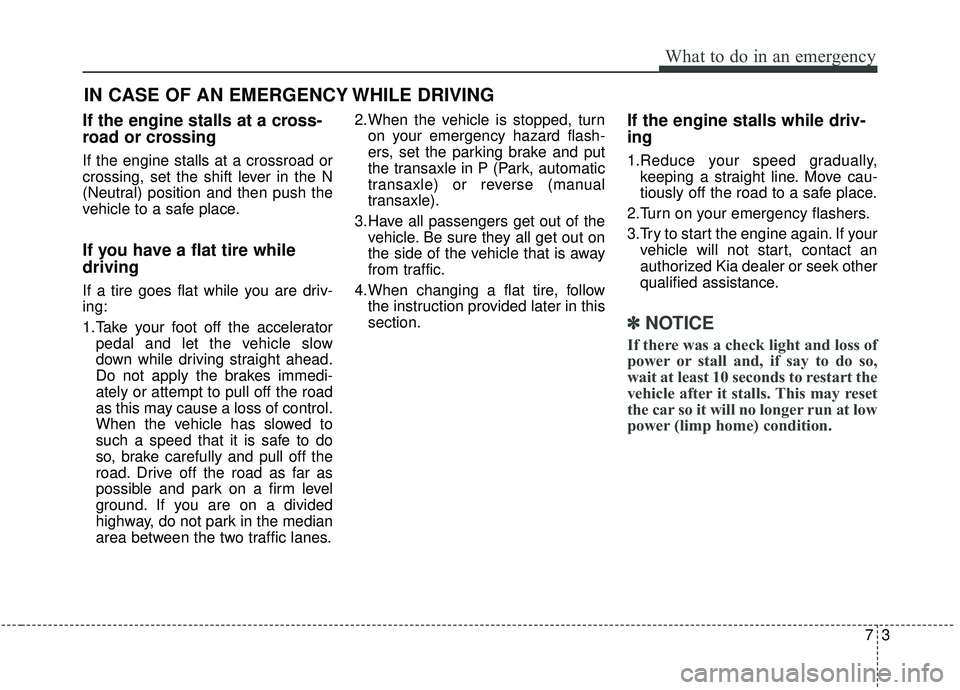
73
What to do in an emergency
If the engine stalls at a cross-
road or crossing
If the engine stalls at a crossroad or
crossing, set the shift lever in the N
(Neutral) position and then push the
vehicle to a safe place.
If you have a flat tire while
driving
If a tire goes flat while you are driv-
ing:
1.Take your foot off the acceleratorpedal and let the vehicle slow
down while driving straight ahead.
Do not apply the brakes immedi-
ately or attempt to pull off the road
as this may cause a loss of control.
When the vehicle has slowed to
such a speed that it is safe to do
so, brake carefully and pull off the
road. Drive off the road as far as
possible and park on a firm level
ground. If you are on a divided
highway, do not park in the median
area between the two traffic lanes. 2.When the vehicle is stopped, turn
on your emergency hazard flash-
ers, set the parking brake and put
the transaxle in P (Park, automatic
transaxle) or reverse (manual
transaxle).
3.Have all passengers get out of the vehicle. Be sure they all get out on
the side of the vehicle that is away
from traffic.
4.When changing a flat tire, follow the instruction provided later in this
section.
If the engine stalls while driv-
ing
1.Reduce your speed gradually,keeping a straight line. Move cau-
tiously off the road to a safe place.
2.Turn on your emergency flashers.
3.Try to start the engine again. If your vehicle will not start, contact an
authorized Kia dealer or seek other
qualified assistance.
✽ ✽ NOTICE
If there was a check light and loss of
power or stall and, if say to do so,
wait at least 10 seconds to restart the
vehicle after it stalls. This may reset
the car so it will no longer run at low
power (limp home) condition.
IN CASE OF AN EMERGENCY WHILE DRIVING
Page 484 of 564
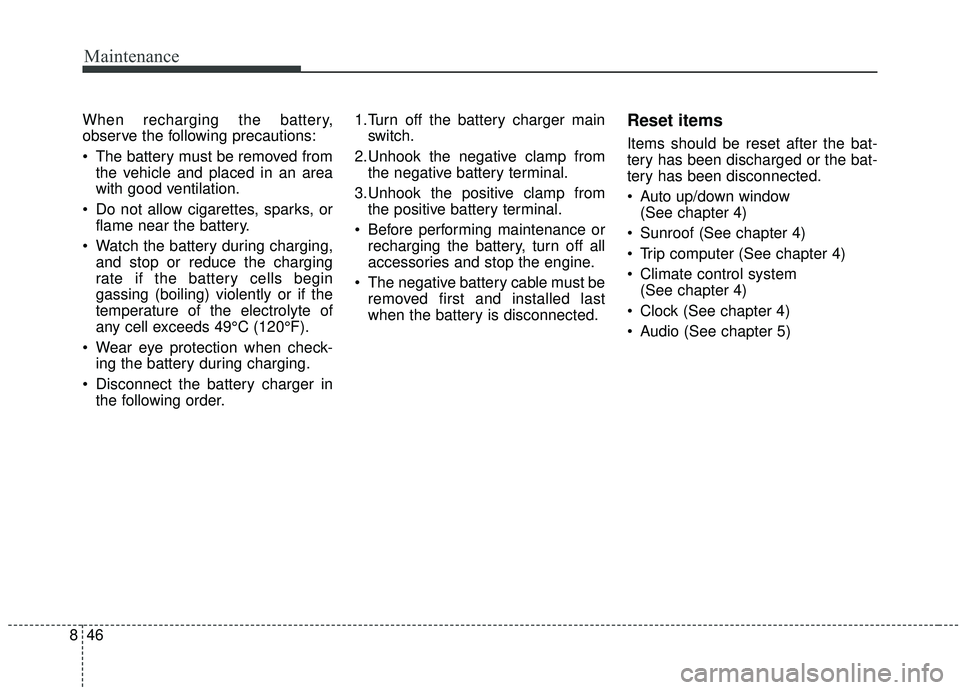
Maintenance
46
8
When recharging the battery,
observe the following precautions:
The battery must be removed from
the vehicle and placed in an area
with good ventilation.
Do not allow cigarettes, sparks, or flame near the battery.
Watch the battery during charging, and stop or reduce the charging
rate if the battery cells begin
gassing (boiling) violently or if the
temperature of the electrolyte of
any cell exceeds 49°C (120°F).
Wear eye protection when check- ing the battery during charging.
Disconnect the battery charger in the following order. 1.Turn off the battery charger main
switch.
2.Unhook the negative clamp from the negative battery terminal.
3.Unhook the positive clamp from the positive battery terminal.
Before performing maintenance or recharging the battery, turn off all
accessories and stop the engine.
The negative battery cable must be removed first and installed last
when the battery is disconnected.Reset items
Items should be reset after the bat-
tery has been discharged or the bat-
tery has been disconnected.
Auto up/down window (See chapter 4)
Sunroof (See chapter 4)
Trip computer (See chapter 4)
Climate control system (See chapter 4)
Clock (See chapter 4)
Audio (See chapter 5)
Page 488 of 564
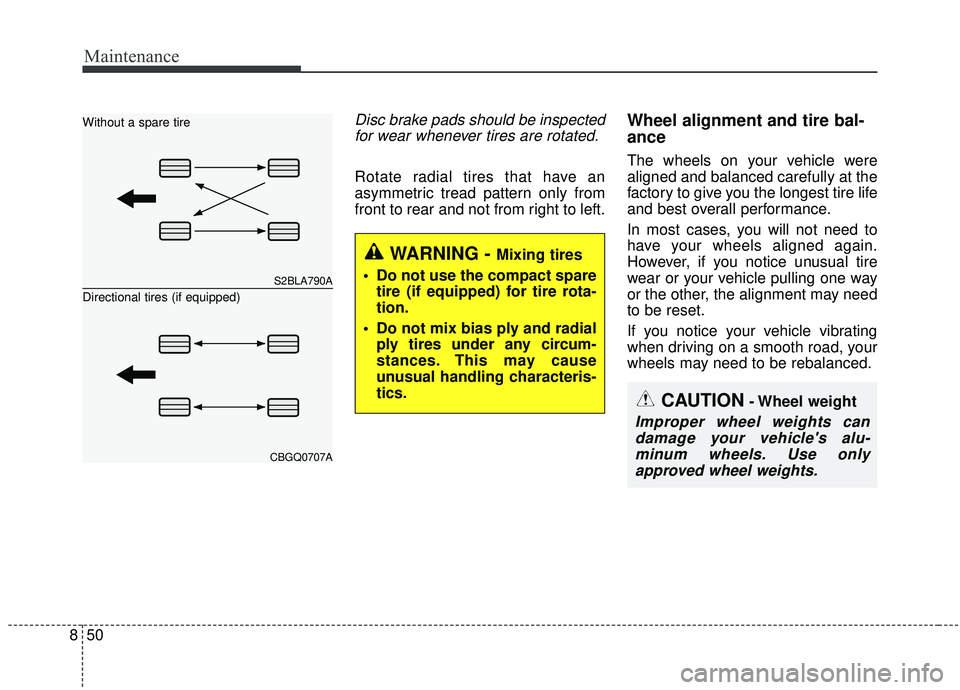
Maintenance
50
8
Disc brake pads should be inspected
for wear whenever tires are rotated.
Rotate radial tires that have an
asymmetric tread pattern only from
front to rear and not from right to left.
Wheel alignment and tire bal-
ance
The wheels on your vehicle were
aligned and balanced carefully at the
factory to give you the longest tire life
and best overall performance.
In most cases, you will not need to
have your wheels aligned again.
However, if you notice unusual tire
wear or your vehicle pulling one way
or the other, the alignment may need
to be reset.
If you notice your vehicle vibrating
when driving on a smooth road, your
wheels may need to be rebalanced.
S2BLA790A
CBGQ0707A
Without a spare tire
Directional tires (if equipped)
CAUTION- Wheel weight
Improper wheel weights candamage your vehicle's alu-minum wheels. Use onlyapproved wheel weights.
WARNING - Mixing tires
Do not use the compact spare tire (if equipped) for tire rota-
tion.
Do not mix bias ply and radial ply tires under any circum-
stances. This may cause
unusual handling characteris-
tics.
Page 503 of 564
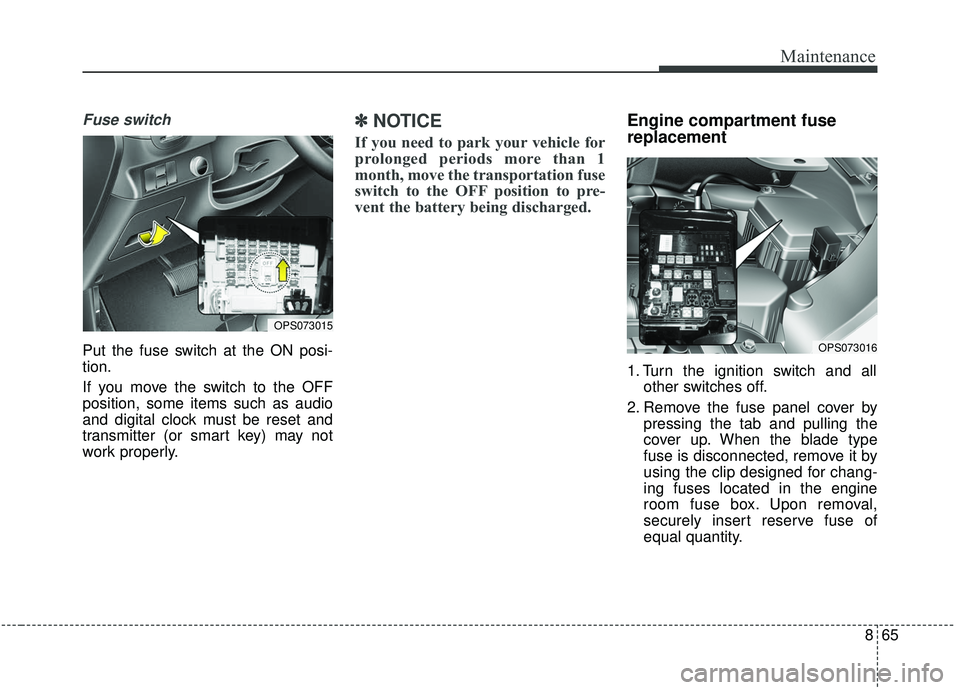
865
Maintenance
Fuse switch
Put the fuse switch at the ON posi-
tion.
If you move the switch to the OFF
position, some items such as audio
and digital clock must be reset and
transmitter (or smart key) may not
work properly.
✽ ✽NOTICE
If you need to park your vehicle for
prolonged periods more than 1
month, move the transportation fuse
switch to the OFF position to pre-
vent the battery being discharged.
Engine compartment fuse
replacement
1. Turn the ignition switch and all
other switches off.
2. Remove the fuse panel cover by pressing the tab and pulling the
cover up. When the blade type
fuse is disconnected, remove it by
using the clip designed for chang-
ing fuses located in the engine
room fuse box. Upon removal,
securely insert reserve fuse of
equal quantity.
OPS073016
OPS073015
Page 557 of 564
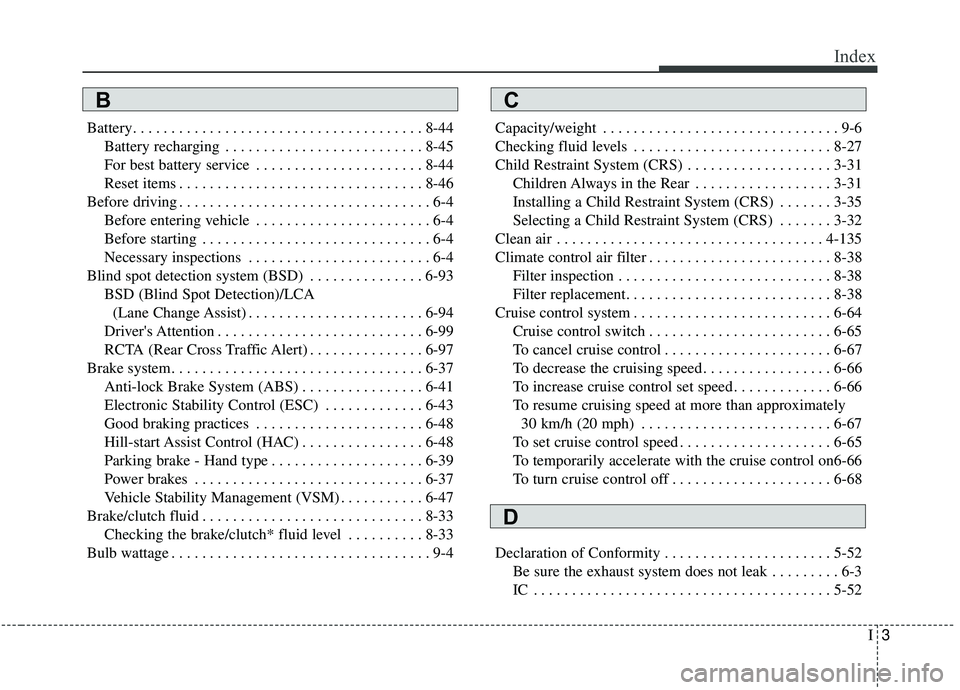
I3
Index
Battery. . . . . . . . . . . . . . . . . . . . . . . . . . . . . . . . . . . . \
. . 8-44Battery recharging . . . . . . . . . . . . . . . . . . . . . . . . . . 8-45
For best battery service . . . . . . . . . . . . . . . . . . . . . . 8-44
Reset items . . . . . . . . . . . . . . . . . . . . . . . . . . . . . . . . 8-46
Before driving . . . . . . . . . . . . . . . . . . . . . . . . . . . . . . . . . 6-4 Before entering vehicle . . . . . . . . . . . . . . . . . . . . . . . 6-4
Before starting . . . . . . . . . . . . . . . . . . . . . . . . . . . . . . 6-4
Necessary inspections . . . . . . . . . . . . . . . . . . . . . . . . 6-4
Blind spot detection system (BSD) . . . . . . . . . . . . . . . 6-93 BSD (Blind Spot Detection)/LCA (Lane Change Assist) . . . . . . . . . . . . . . . . . . . . . . . 6-94
Driver's Attention . . . . . . . . . . . . . . . . . . . . . . . . . . . 6-99
RCTA (Rear Cross Traffic Alert) . . . . . . . . . . . . . . . 6-97
Brake system. . . . . . . . . . . . . . . . . . . . . . . . . . . . . . . . . 6-37 Anti-lock Brake System (ABS) . . . . . . . . . . . . . . . . 6-41
Electronic Stability Control (ESC) . . . . . . . . . . . . . 6-43
Good braking practices . . . . . . . . . . . . . . . . . . . . . . 6-48
Hill-start Assist Control (HAC) . . . . . . . . . . . . . . . . 6-48
Parking brake - Hand type . . . . . . . . . . . . . . . . . . . . 6-39
Power brakes . . . . . . . . . . . . . . . . . . . . . . . . . . . . . . 6-37
Vehicle Stability Management (VSM) . . . . . . . . . . . 6-47
Brake/clutch fluid . . . . . . . . . . . . . . . . . . . . . . . . . . . . . 8-33 Checking the brake/clutch* fluid level . . . . . . . . . . 8-33
Bulb wattage . . . . . . . . . . . . . . . . . . . . . . . . . . . . . . . . . . 9-4 Capacity/weight . . . . . . . . . . . . . . . . . . . . . . . . . . . . . . . 9-6
Checking fluid levels . . . . . . . . . . . . . . . . . . . . . . . . . . 8-27
Child Restraint System (CRS) . . . . . . . . . . . . . . . . . . . 3-31
Children Always in the Rear . . . . . . . . . . . . . . . . . . 3-31
Installing a Child Restraint System (CRS) . . . . . . . 3-35
Selecting a Child Restraint System (CRS) . . . . . . . 3-32
Clean air . . . . . . . . . . . . . . . . . . . . . . . . . . . . . . . . . . . 4-\
135
Climate control air filter . . . . . . . . . . . . . . . . . . . . . . . . 8-38 Filter inspection . . . . . . . . . . . . . . . . . . . . . . . . . . . . 8-38
Filter replacement. . . . . . . . . . . . . . . . . . . . . . . . . . . 8-38
Cruise control system . . . . . . . . . . . . . . . . . . . . . . . . . . 6-64 Cruise control switch . . . . . . . . . . . . . . . . . . . . . . . . 6-65
To cancel cruise control . . . . . . . . . . . . . . . . . . . . . . 6-67
To decrease the cruising speed . . . . . . . . . . . . . . . . . 6-66
To increase cruise control set speed . . . . . . . . . . . . . 6-66
To resume cruising speed at more than approximately 30 km/h (20 mph) . . . . . . . . . . . . . . . . . . . . . . . . . 6-67
To set cruise control speed . . . . . . . . . . . . . . . . . . . . 6-65
To temporarily accelerate with the cruise control on6-66
To turn cruise control off . . . . . . . . . . . . . . . . . . . . . 6-68
Declaration of Conformity . . . . . . . . . . . . . . . . . . . . . . 5-52 Be sure the exhaust system does not leak . . . . . . . . . 6-3
IC . . . . . . . . . . . . . . . . . . . . . . . . . . . . . . . . . . . . \
. . . 5-52
BC
D